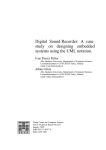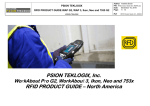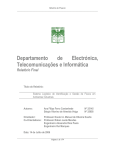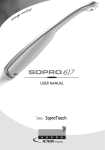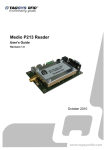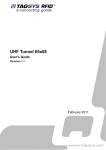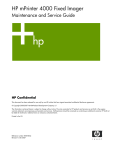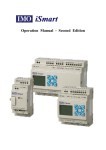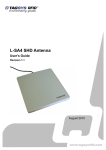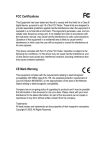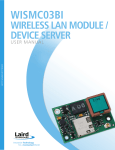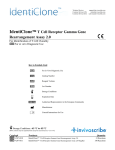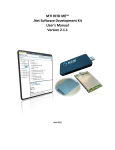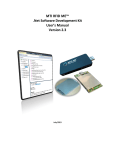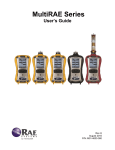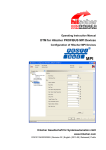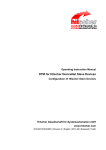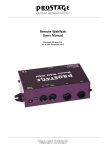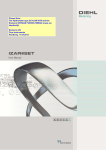Download HHU500 User Guide
Transcript
HHU500 User Guide Revision 1.1 May 2013 HHU500 User's Guide Publishing Information Disclaimer and Limitation of Liability All information herein is either public information or is the property of and owned solely by TAGSYS who shall have and keep the sole right to file patent applications or any other kind of intellectual property protection in connection with such information. Nothing herein shall be construed as implying or granting to you any rights, by license, grant or otherwise, under any intellectual and/or industrial property rights of or concerning any of TAGSYS’ information. This document can be used for informational, non-commercial, internal and personal use only provided that: The copyright notice below, the confidentiality and proprietary legend and this full warning notice appear in all copies. This document shall not be posted on any network computer or broadcast in any media and no modification of any part of this document shall be made. Use for any other purpose is expressly prohibited and may result in severe civil and criminal liabilities. The information contained in this document is provided “AS IS” without any warranty of any kind. Unless otherwise expressly agreed in writing, TAGSYS makes no warranty as to the value or accuracy of information contained herein. The document could include technical inaccuracies or typographical errors. Changes are periodically added to the information herein. Furthermore, TAGSYS reserves the right to make any change or improvement in the specifications data, information, and the like described herein, at any time. Therefore TAGSYS assumes no liability and is not responsible for customer applications or product or software which includes TAGSYS products. TAGSYS HEREBY DISCLAIMS ALL WARRANTIES AND CONDITIONS WITH REGARD TO THE INFORMATION CONTAINED HEREIN, INCLUDING ALL IMPLIED WARRANTIES OF MERCHANTABILITY, FITNESS FOR A PARTICULAR PURPOSE, TITLE AND NON-INFRINGEMENT. IN NO EVENT SHALL TAGSYS BE LIABLE, WHETHER IN CONTRACT, TORT OR OTHERWISE, FOR ANY INDIRECT, SPECIAL OR CONSEQUENTIAL DAMAGES OR ANY DAMAGES WHATSOEVER INCLUDING BUT NOT LIMITED TO DAMAGES RESULTING FROM LOSS OF USE, DATA, PROFITS, REVENUES, OR CUSTOMERS, ARISING OUT OF OR IN CONNECTION WITH THE USE OR PERFORMANCE OF INFORMATION CONTAINED IN THIS DOCUMENT. TAGSYS does not and shall not warrant that this product/system/equipment will be resistant to all possible attacks, and shall not incur, and disclaims, any liability in this respect. Even if each product is compliant with current security standards in force on the date of their design, security mechanisms' resistance necessarily evolves according to the state-of-the-art in security and notably under the emergence of new attacks. Under no circumstances shall TAGSYS be held liable for any third party actions, and in particular in case of any successful attack against systems or equipment incorporating TAGSYS products. TAGSYS disclaims any liability with respect to security for direct, indirect, incidental or consequential damages that result from any use of its products. It is further stressed that independent testing and verification by the person using the product is particularly encouraged, especially in any application in which defective, incorrect, or insecure functioning could result in damage to persons or property, denial of service, or loss of privacy. All TAGSYS products are subject to careful quality control throughout the manufacturing process and are warranted to be of merchantable quality and free from manufacturing defects. Published information concerning TAGSYS products are based upon research which the Company believes to be reliable but such information do not constitute a warranty. Because of the variety of possible uses for TAGSYS products and the continuing development of new uses, the purchaser should carefully consider the fitness and performance of the product for each intended use and the purchaser assumes all risks in connection with such use. Seller shall not be liable for damages in excess of the purchase price of the product or for incidental or consequential damages. All specifications are subject to change without prior notice. © 2000-2013 TAGSYS SAS. All rights reserved. All trademarks and registered trademarks are the property of their respective owners. Printed in France. TAGSYS – 785 Voie Antiope, Athélia III, 13600 LA CIOTAT, France. Tel: +33 (0)4.42.18.89.00 / Fax: +33 (0)4.42.18.89.01 Document Reference: DOC15481A1 2/41 Revision 1.1 May 2013 HHU500 User Guide Read This First Welcome to the TAGSYS RFID System. This User Guide is designed to help you get up and running quickly using this high-quality Radio Frequency Identification (RFID) system. It describes all you need to know about how to install and use the TAGSYS system and its associated applications. It provides a step-by-step guide for the following procedures: Installation of the HHU500 Configuring the product for use within your application This guide is designed for all CIT (Certified Integrators by TAGSYS) and for TAGSYS Expert Network customers implementing a low-cost and high-performance RFID solution. This document does not assume any previous knowledge of Radio Frequency Identification (RFID) technology. Conventions Symbol Meaning CAUTION: A note that advises users that a specific action could result in the loss of data or damage the hardware. WARNING: A note that advises users that a specific action may result in physical harm. A note that provides additional information that helps the user performing a task or obtaining the best performance from the product. If you need assistance Please contact your nearest TAGSYS Sales Representative or the TAGSYS Welcome Desk at: Telephone: +33 (0)4 42 18 89 00 Fax: +33 (0)4 42 18 89 01 E-Mail: [email protected] Website: http://www.tagsysrfid.com Contact for Comments We welcome your feedback to help us provide high quality documentation. For technical comments, please contact our Welcome Desk: Telephone: +33 (0)4 42 18 89 00 Fax: +33 (0)4 42 18 89 01 E-Mail: [email protected] May 2013 Revision 1.1 3/41 HHU500 User's Guide Please remember to quote the Document Reference Number DOC15481A1, your job title and your company. Quality Issues TAGSYS implements stringent quality controls at all stages of its manufacturing process. However, should you find a defect with this product, please notify your TAGSYS Quality Service representative using the dedicated Product Return Form. 4/41 Telephone: +33 (0)4 42 18 89 00 E-Mail: [email protected] Revision 1.1 May 2013 HHU500 User's Guide Table of Contents PUBLISHING INFORMATION __________________________________________________________ 2 DISCLAIMER AND LIMITATION OF LIABILITY __________________________________________________ 2 READ THIS FIRST ____________________________________________________________________ 3 CONVENTIONS _________________________________________________________________________ 3 IF YOU NEED ASSISTANCE ________________________________________________________________ 3 CONTACT FOR COMMENTS _______________________________________________________________ 3 QUALITY ISSUES _______________________________________________________________________ 4 1 FOR YOUR SAFETY _______________________________________________________________ 7 1.1 GENERAL USE ____________________________________________________________________ 7 1.2 CARE AND MAINTENANCE ___________________________________________________________ 7 1.3 IMPORTANT SAFETY INFORMATION ____________________________________________________ 8 1.3.1 OPERATING ENVIRONMENT _________________________________________________________ 8 2 CERTIFICATION ___________________________________________________________________ 9 2.1 OCCUPATIONAL HEALTH ____________________________________________________________ 9 2.2 REGULATORY NOTICES _____________________________________________________________ 9 2.2.1 IN EUROPE (CE AND RTTE DIRECTIVES) _____________________________________________ 9 2.2.2 IN USA (FCC DIRECTIVE) _________________________________________________________ 10 2.3 ROHS (RESTRICTION OF THE USES OF CERTAIN HAZARDOUS SUBSTANCES) ________________ 11 2.4 WEEE (WASTE ELECTRICAL AND ELECTRONIC EQUIPMENT) _____________________________ 11 3 INTRODUCTION __________________________________________________________________ 12 3.1 PRODUCT DESCRIPTION ____________________________________________________________ 12 3.2 DELIVERY _______________________________________________________________________ 13 4 USING THE HHU500 ______________________________________________________________ 14 4.1 4.2 4.3 4.4 4.5 4.6 4.7 POWERING ON/OFF _______________________________________________________________ 14 BATTERY MONITORING _____________________________________________________________ 15 BATTERY RECHARGING ____________________________________________________________ 16 BATTERY SAFETY PRECAUTIONS _____________________________________________________ 17 APPLICATION CONTROLLED FEATURES _______________________________________________ 18 BLUETOOTH COMMUNICATION INTERFACE_____________________________________________ 18 OPERATING THE HHU500 __________________________________________________________ 19 5 POCKET PC DEMO SOFTWARE ___________________________________________________ 21 5.1 SOFTWARE DESCRIPTION ___________________________________________________________ 21 5.2 CONFIGURING THE POCKET PC _____________________________________________________ 21 5.3 INSTALLING THE DEMO SOFTWARE ___________________________________________________ 21 May 2013 Revision 1.1 5/41 HHU500 User's Guide 5.4 USING THE DEMO SOFTWARE________________________________________________________ 22 5.4.1 STARTING THE DEMO SOFTWARE ___________________________________________________ 22 5.4.2 CONFIGURING READER AND DEMO SOFTWARE ________________________________________ 23 5.4.3 READING TAGS __________________________________________________________________ 24 6 PC DEMO SOFTWARE ____________________________________________________________ 26 6.1 6.2 6.3 6.4 INSTALLING THE APPLICATION _______________________________________________________ 26 RUNNING THE APPLICATION _________________________________________________________ 26 CONFIGURING THE APPLICATION _____________________________________________________ 28 READING TAGS ___________________________________________________________________ 32 7 OPERATION _____________________________________________________________________ 34 7.1 READER SETTINGS ________________________________________________________________ 34 8 APPLICATION DEVELOPMENT ____________________________________________________ 35 8.1 SOFTWARE OVERVIEW _____________________________________________________________ 35 8.2 READING PROCESS _______________________________________________________________ 35 8.2.1 COMMUNICATION INITIALIZATION ___________________________________________________ 35 8.2.2 HHU500 INITIALIZATION __________________________________________________________ 36 8.2.3 TAG READING CYCLES ___________________________________________________________ 37 9 TECHNICAL SPECIFICATIONS ____________________________________________________ 38 10 WARRANTY CONDITIONS ________________________________________________________ 39 10.1 WARRANTY _____________________________________________________________________ 39 10.2 WARRANTY EXCLUSIONS __________________________________________________________ 39 10.2.1 GENERAL PROVISIONS __________________________________________________________ 40 10.2.2 HOW TO RETURN DEFECTIVE PRODUCTS ___________________________________________ 40 6/41 Revision 1.1 May 2013 HHU500 User's Guide 1 For Your Safety 1.1 General Use The HHU500 is designed to be reliable and to provide years of trouble-free service. Please observe the following general tips: Take care not to scratch the device. Keep the device clean. When working with the device, use only TAGSYS-approved accessories. This device is not waterproof and should not be exposed to rain or moisture. Under extreme conditions, water may enter the circuitry. Protect the device from extreme temperatures. For example, do not place the device in a windowed area where the sun may cause extreme temperatures, and keep it away from heaters and other heat sources. Do not store or use the device in any location that is extremely dusty, damp, or wet. Use a soft, damp cloth to clean the device. If the surface of the device becomes soiled, clean it with a soft cloth moistened with a diluted window-cleaning solution. 1.2 Care and Maintenance This device is a product of superior design and should be handled with care. The suggestions below will further increase the lifetime of this device. • Keep the device and all parts and accessories out of the reach of small children. • Keep the device dry. Precipitation, humidity and liquids contain minerals that will corrode electronic circuits. • Do not use or store the device in dusty, dirty areas. Its moving parts can be damaged. • Do not store in hot areas. High temperatures can shorten the life of electronic devices, damage batteries and warp or melt certain plastics. • Do not store in cold areas. When the device warms up (to its normal temperature), moisture can form inside the device, which may damage electronic circuit boards. • Do not attempt to open the device. Non-professional handling of the device may damage it. • Handle the device with care. Shocks may break internal circuit boards. • Do not bend the antenna part or lean on it. • Do not clean the device with harsh chemicals, cleaning solvents or strong detergents. Gently wipe the device with a soft cloth slightly dampened in a mild soap-and-water solution. • Do not paint the device. Paint may clog the device’s moving parts and prevent proper operation. Paint with metallic contents may limit device performances. • If the device or any accessory are not working properly, take it to your nearest qualified TAGSYS representative. May 2013 Revision 1.1 7/41 HHU500 User's Guide 1.3 Important Safety Information 1.3.1 Operating Environment When connecting the device or any accessory to another device, read its user guide for detailed safety instructions. Do not connect incompatible products. As with all RF equipment, users are advised that the equipment should only be used in its normal operating position. 8/41 Revision 1.1 May 2013 HHU500 User's Guide 2 Certification 2.1 Occupational Health The HHU500 has been designed and tested to be in conformity with the European Standard EN 50364 “Limitation of human exposure to electromagnetic fields from devices used in Electronic Article Surveillance (EAS), Radio Frequency Identification (RFID) and similar applications” in conjunction with the European Standard EN 50357 describing how to evaluate the exposure level. 2.2 Regulatory Notices An RFID system typically composed of an RF emission device such as the HHU500 connected to an antenna is subject to national regulations that may differ by country. 2.2.1 In Europe (CE and RTTE Directives) The HHU500 complies with the European EMC directive. (CE Declaration of Conformity granted) The HHU500 complies with the requirements of the Telecommunication Terminal Equipment Act (FTEG) and the RTTE Directive 1995/5/CE. The HHU500 has been designed and tested to be in conformity with EN 302 208-1 v1.4.1, EN 302 208-2 v1.4.1, EN 300 328 v1.7.1, EN 301 489-3 v1.4.1, EN 301 489-1 v1.8.1, EN 301 489-17 v2.1.1 specifications. It is the responsibility of the Buyer to use the HHU500 as described in this User Guide or TAGSYS Documentation. Any modification of the HHU500 is prohibited without the written consent of TAGSYS. Unauthorized modification may void the conformity of the equipment to CE and RTTE Directives and will void the TAGSYS warranty. If the HHU500 is further integrated in a different product, it is the responsibility of the manufacturer of this complementary product to obtain the required approvals for this product. May 2013 Revision 1.1 9/41 HHU500 User's Guide 2.2.2 In USA (FCC Directive) The HHU500 has been designed to comply with Part 15 of the FCC Rules. HHU500-US WARNING TO USERS IN THE UNITED STATES FEDERAL COMMUNCIATIONS COMMISSION (FCC) RADIO INTERFERENCE STATEMENT 47 CFR Section 15.105(b) This equipment has been tested and found to comply with the limits for a Class B digital device, pursuant to Part 15 of the FCC Rules. These limits are designed to provide reasonable protection against harmful interference in a residential installation. This equipment generates, uses and can radiate radio frequency energy and, if not installed and used in accordance with the instruction, may cause harmful interference to radio communications. However, there is no guarantee that interference, will not occur in a particular installation. If this equipment does cause harmful interference to radio or television reception which can be determined by turning the equipment off and on, the user is encouraged to try to correct the interference by one or more of the following measures: ▪ Reorient or relocate the receiving antenna. ▪ Increase the separation between the equipment and receiver. ▪ Connect the equipment into an outlet on a circuit different to that to which the receiver is connected. ▪ Consult the dealer or an experienced radio/TV technician for help. NO UNAUTHORIZED MODIFICATIONS 47 CFR Section 15.21 CAUTION: This equipment may not be modified, altered, or changed in any way without signed written permission from TAGSYS SA. Unauthorized modification may void the equipment authorization from the FCC and will void the TAGSYS warranty. Operation is subject to the following two conditions: (1) The system devices may not cause harmful interference, and (2) The system devices must accept any interference received, including interference that may cause undesired operation. 10/41 Revision 1.1 May 2013 HHU500 User's Guide 2.3 RoHS (Restriction of the uses of certain Hazardous Substances) TAGSYS certifies that this product is compliant with the European Directive 2002/95/EC for the restriction in Electric and Electronic Equipment (RoHS) of the use of the following hazardous substances: • Lead • Mercury • Cadmium • Hexavalent Chromium • Polybrominated biphenyl flame retardants • Polybrominated diphenyl ether flame retardants This declaration is based on information provided by our suppliers and subcontractors. 2.4 WEEE (Waste Electrical and Electronic Equipment) This product bears the selective sorting symbol for waste electrical and electronic equipment (WEEE) This means that this product must be handled pursuant to European Directive 2002/96/EC in order to be recycled or dismantled to minimize its impact on the environment. Do not dispose of your old product in your general household waste bin. For further information, please contact your local or regional authorities. May 2013 Revision 1.1 11/41 HHU500 User's Guide 3 Introduction 3.1 Product Description The HHU500 is a light-weight RFID reader, designed for mobile RFID inventory operations providing a large area of detection in an ergonomic and low profile package. The reader exchanges data with the host application through a wireless connection using the Bluetooth communication interface, providing the user complete freedom of movement. The HHU500 is power supplied by a Li-Ion rechargeable battery providing approx.4 hours of use in continuous reading operation (at 25°C nominal tempe rature). The HHU500 features 2 capacitive touch buttons for powering On/Off the product and user application purpose, as well leds for battery charging status, battery level monitoring and user application purpose. It includes also a buzzer which is software-configurable by user application. Figure 1: HHU500 description Battery charging status leds Power On/Off touch button Battery level and application controlled leds Application controlled touch button 12/41 Revision 1.1 May 2013 HHU500 User's Guide 3.2 Delivery The HHU500 Kit contains the following items: Table 1: Package Contents Quantity Item 1 HHU500 1 AC/DC Power supply pack 1 CD-ROM including : 1 May 2013 • HHU500 User Guide • TAGSYS Software Development Kits including: o Native DLL package for Windows CE family (PocketPC 2003, Windows Mobile 5.x, Windows Mobile 6.x running on ARM processor), Windows XP, Vista and Seven operating systems running either in 32-bit or 64-bit mode o Demo software for Pocket PC with Visual C++ source code o DLL Programming Guide • User-friendly PC demo software for test on Windows XP, Vista and Seven operating system running either in 32-bit or 64-bit mode Welcome Letter / Product Return Form Revision 1.1 13/41 HHU500 User's Guide 4 Using the HHU500 This section describes how to use the HHU500. Actual product may differ from pictures here after. 4.1 Powering On/Off A specific touch button placed on top of the product shall be used to switch the product ON or OFF: Place your finger onto this symbol during 3 sec. minimum as shown on the figure below. When the product goes ON, the battery level and user leds light on (orange and green color, at middle of the wand) and buzzer beeps. Figure 2: Power On/Off touch button 14/41 Revision 1.1 May 2013 HHU500 User's Guide Figure 3: Battery level led To switch the product OFF, place your finger onto the power On/Off touch button for minimum 3 sec. Battery level led (green color) shall go off. 4.2 Battery monitoring Battery level is continuously monitored by the reader. Four different battery statuses are defined: “Full”, “Medium”, “Low”, and “Very Low”. At application level, they are accessible through a specific DLL command (See “DLL programming Guide”). When “Very Low” level is reported, battery has reached its minimum capacity and it is required to immediately recharge it. Product will be automatically switched off after 15 min approx. at this level, to prevent permanent damages to battery. It is strongly advised to not wait for this level to be reached before recharging the battery. Power level led indicates also battery level status. When this led is: - Continuously ON: battery is charged - Blinking 1 time/sec: battery charge is at low level - Blinking 5 times/sec: battery charge is at very low level. Battery needs to be recharged (approx. 15 min remaining before automatic reader switching off) When battery is fully discharged, 5 fast beeps can be heard as well application leds (green and orange leds) blink. HHU500 enters in self-protection mode and is automatically switched off (not operating). Product must be immediately recharged. May 2013 Revision 1.1 15/41 HHU500 User's Guide 4.3 Battery recharging When battery level led (green led) blinks 5 times/sec or "Very Low" status is reported to the host, battery has reached its minimum capacity and it is required to immediately recharge the product. Connect the female jack connector of the provided power supply equipment into the male jack connector of the product, as shown in the figure below. In recharging mode, HHU500 is not operating and therefore cannot be used for inventory operations. Only use the power supply provided with the product to recharge it. Using different equipment might irreversibly damage the product. Figure 4: Battery in charge A red led lights ON means product is in charge. 16/41 Revision 1.1 May 2013 HHU500 User's Guide Figure 5: Battery recharged A green led lights ON means battery charging cycle is completed. Full recharging process may last up to 3.5 hours approx. 4.4 Battery safety precautions As for any Li-Ion battery powered product, in order to maximize battery life and capacity, it is strongly advised to not store HHU500 product for long periods without using or fully recharging it. Battery used in this product may present a risk of fire or chemical burn if mistreated. HHU500 must not be opened or disassembled (except by a TAGSYS qualified and trained staff), heat above 100°C (212°F), incinerated, imme rse and throw/wet in water. May 2013 Revision 1.1 17/41 HHU500 User's Guide 4.5 Application controlled features A specific touch button and an orange led placed at the middle of the product, as well as a buzzer are software-configurable for application purposes. These devices can be directly monitored at application level using specific commands (See "DLLs Programming Guide"). Figure 6: Application controlled touch button and orange led Three different actions on the application controlled touch button can trig specific operations (see "DLLs Programming guide"): - Single click : one click in a 500 ms window - Double short clicks : two successive clicks separated by less than 500 ms - Long click : one click kept 2 sec minimum 4.6 Bluetooth Communication Interface TAGSYS’ HHU500 implements Bluetooth Serial Port Profile (SPP). This means that, once connection to the reader is established, it appears as a standard serial port (i.e. COM port) to the host platform. The procedure to discover reader and establish connection to it depends on operating system and Bluetooth driver. Please refer to your host device user manual for information. 18/41 Revision 1.1 May 2013 HHU500 User's Guide TAGSYS’ HHU500 is always identifiable. By default, its device name is set to “TAGSYS HHU500-EU” or “TAGSYS HHU500-US”. Pin code is “0000”. When host device runs Windows CE operating system, Bluetooth COM port number assigned to the reader must be lower than 10 as greater values are not supported by Windows CE SDK and demo application. Please refer to your host device user’s manual for information about how to select Bluetooth COM port number. Reader device name is always customizable at application level using either a specific command from SDK (See more details in DLLs Programming Guide), or “TAGSYS UHF Explorer” delivered with this product (“Settings” window, see 6.3 chapter here after). HHU500 reader must be power cycled after its Bluetooth name has been modified in order for changes to take effect. 4.7 Operating the HHU500 May 2013 Revision 1.1 19/41 HHU500 User's Guide When using the HHU500 reader, wear the wrist strap. Handle the product with care. Do not let it go of, and do not drop it on the ground. Switch ON the HHU500. The green led at the middle of the product shall light on. The host demo application can then be started (provided onto the product CD ROM for PC or Pocket PC) A software development kit included in the CD-ROM can be used to develop an application on Windows 200x, XP, Vista and Seven operating system running either in 32-bit or 64-bit mode. A software development kit for Windows CE (Arm processor) and demo software for Pocket PC are also supplied with source code. Antenna radiation pattern: Antenna radiates in all directions according to the pattern here below. 20/41 Revision 1.1 May 2013 HHU500 User's Guide 5 Pocket PC Demo Software 5.1 Software description The demo software and its associated source code are designed to provide a simple example for using the HHU500 to perform the following operations: • Configure reader parameters • Read tags This software is an educational aid. It is a starting point for developing characteristic applications designed to meet requirements for specific end-user environments. Demo software is compatible with any Arm processor QVGA Pocket PC device running Windows CE family of operating systems (PocketPC 2003, Windows Mobile 5.x, Windows Mobile 6.x). The Pocket PC must obviously be equipped with a Bluetooth communication interface in order to communicate with the HHU500. 5.2 Configuring the Pocket PC Before using Pocket PC demo software, communication must be established to the HHU500 (see section 4.3). No other configuration is required. 5.3 Installing the demo software To install the demo software on your Pocket PC device, insert the product CD-ROM into the disk drive on your PC and browse to “\Pocket PC (Arm) Demo Software” directory. Copy the file named “UHF Wand Demo v1.1.0 Installer.cab” from the CD-ROM to any location on your Pocket PC device. Start File Explorer on the Pocket PC, browse to the location where you copied the cab file. Click on the cab file then follow the instructions that appear on the screen. Demo application is now installed on Pocket PC. A shortcut to the demo application is created in “Programs” menu. May 2013 Revision 1.1 21/41 HHU500 User's Guide 5.4 Using the demo software 5.4.1 Starting the demo software Be sure that HHU500 reader is powered-on, and that your Pocket PC’s Bluetooth interface is properly started and configured (see section 4.3). In “Programs” menu, click UHF wand demo. The application starts and tries to connect to the HHU500 reader. If connection is successful, the following window appears: SDK version and application status Battery charge level Frame counter Tag counter Success rate Tag list Start/Stop reading process Open settings window Clear display Exit application If connection to the HHU500 fails, application status section displays “Not connected”. In this case, please ensure that reader is powered-on and that Bluetooth connection is properly established. Also ensure that the proper COM port is selected in demo software settings window (see section 5.4.2). SDK Version and application status: Displays the version of the DLL currently in use as well as application status (i.e. not connected, connecting, ready or reading). Battery charge level: Displays remaining battery power as a progress bar. Frame counter: Displays the total number of tag frames (i.e. messages) detected during the read session (the same tag can be detected several times during the read session). Tag counter: Displays the total number of different tags detected during the read session. If a reference list is used, total number of expected tags is also displayed. See section 5.4.2 for more information about reference list. 22/41 Revision 1.1 May 2013 HHU500 User's Guide Success rate: If a reference list is used, displays the detected vs. expected tag ratio as a percentage. See section 5.4.2 for more information about reference list. Tag list: Displays the list of different ePC tag data detected during the read session. Start/Stop reading process: Starts / Stops a read session. Open settings window: Opens settings window. See section 5.4.2 for details. Clear display: Clears tag list and counters. Exit application: Ends communication to the HHU500 and exits application. 5.4.2 Configuring reader and demo software To open configuration window, click settings icon in main window (see section 5.4.1). The following window pops up: COM Port: The Bluetooth virtual COM port affected to the HHU500. Power (cdBm): The output power in Centi-dBm to be used during a read session. (Example: 10 dBm = 1000 cdBm) Region: The region settings to be used during a read session. May 2013 Revision 1.1 23/41 HHU500 User's Guide User Mode: The user mode to be used during a read session (default, printer, portal, conveyor). Power Mode: The power mode to be used during a read session (high performance, low power). Read Timeout (ms): The duration of read cycles in milliseconds. Ref. List Contents: The number of tags currently contained in the reference list. Ref. List Mode: Indicates how the reference list will be used during subsequent read operations: • Don’t use: During read sessions, all detected tags are displayed whether or not they are in reference list. In this case, success rate is not available. • Use: During read sessions, only detected tags that are in reference list are displayed. In this case, success rate is available. • Build: This mode is used to create a reference list. At the beginning of read sessions, reference list is cleared, then all detected tags are displayed and inserted into the reference list. In this case, success rate is not available. Click “OK” to apply changes, or “Cancel” to discard them. 5.4.3 Reading tags In the main window, ensure that connection to reader is properly established (see section 5.4.1), then click start icon (see section 5.4.1). Reader is now attempting to read tags. Picture below shows an example of display during a read session. 24/41 Revision 1.1 May 2013 HHU500 User's Guide To abort a read session, click stop icon (see section 5.4.1). May 2013 Revision 1.1 25/41 HHU500 User's Guide 6 PC Demo Software The HHU500 station can be tested using “TAGSYS UHF Explorer”. This utility can be used to configure the HHU500 reader and perform reading operations. This section describes how to start with “TAGSYS UHF Explorer Software”. 6.1 Installing the application To install "TAGSYS UHF Explorer", insert the product CD-ROM into the disk drive on your PC and run the setup "TAGSYS UHF Explorer vx-y-z Installer.msi" from “\Demo Software” directory and follow the different installer steps. A shortcut will be created on your desktop and a program group will be created in the start menu. 6.2 Running the application Before running “TAGSYS UHF Explorer” software, be sure that the HHU500 is powered up, PC Bluetooth communication activated and connected with the HHU500. Run “TAGSYS UHF Explorer”. The following window appears: 26/41 Revision 1.1 May 2013 HHU500 User's Guide - Green button is the Start/Stop Read button (toggle button) - Blue button gives access to the “Settings” window of the application - Red button : exit of the application “Bulk read” area reports: - Referenced tags read meaning all read tags (EPC data) part of a specific reference list (list selected before in “Settings” window). Specific counters reflect how many tags have been read compared with total expected tags of this reference list, as well the associated success read rate. - Non-Referenced read tags meaning all read tags (EPC data) which are not part of any selected reference list. A specific counter reflects how many of these tags have been read. “Total frames” counter reports total received tags frames. “Battery level” is an indicator of battery charge status. May 2013 Revision 1.1 27/41 HHU500 User's Guide 6.3 Configuring the application Click on the blue tool button and set all different parameters to be used: - 28/41 First tab gives access to reader parameters configuration/information: o COM port: It is the assigned value by Windows PC to be used for the Bluetooth connection with HHU500 reader. o Read timeout (ms): amount of time allocated by the reader for the read session. o Power (cdBm): power value to be used by the reader for the read session (500 to 3000 cdBm, 50 cdBm steps). o Region: region mode to be selected according with product version in use (EU3 for HHU500-EU and US for HHU500-US) Revision 1.1 May 2013 HHU500 User's Guide - May 2013 o User mode: pre-defined Gen2 parameters settings, optimized for different reading strategies. For inventory applications with multiple static tags in the antenna field, it is recommended to use the “Portal” user mode. o Power mode: power transmit mode to be used during a read session. For this product, it is recommended to use the “Low power” setting value. o Bluetooth name: set/retrieve the Bluetooth name of HHU500 reader. New name must not exceed 23 characters and allowed characters are letters “a-z”, “A-Z”, digits “0-9”, space, minus sign “-“, underscore sign “_”. Reader has to be power cycled for changes to take effect. o Use button to start reading: if checked, reading operation will be triggered/stopped by user double clicks action on application controlled touch button. o Reader version: reports firmware and hardware versions of embedded UHF module. o Board controller version: reports board controller firmware version o “Display Mode” selects the way referenced tag ePCs are reported in “Bulk Read” panel. They are either appended to reference list area or removed from this list as they are read (reverse inventory). o If “Beep on read” is selected, a sound will be emitted each time a tag is read. o If “Log reads” is selected, tag reads will be saved to disk in the application directory (Logs subfolder). “Reference Lists” page (second tab) allows the user to define and name several lists of referenced tags, and select whether or not they will be active for further read operations. Revision 1.1 29/41 HHU500 User's Guide - 30/41 “Reference Lists Contents” page (third tab) allows the user to populate reference lists defined in “Reference Lists” page. Reference lists can also be cleared, saved to or loaded from disk as "*.csv" files. Revision 1.1 May 2013 HHU500 User's Guide May 2013 Revision 1.1 31/41 HHU500 User's Guide 6.4 Reading Tags Tags reading are performed by clicking on green Start button of main screen: “Bulk read” window reports and sorts read tags (EPC data, reference list name, number of received frames for a given tag) into Referenced/Non-Referenced categories. 32/41 Revision 1.1 May 2013 HHU500 User's Guide “RSSI plots” window displays for each read tag the RSSI and reading time values. RSSI is the Return Strength Signal Indicator. These values are displayed only when the reading operation is stopped (Green button): May 2013 Revision 1.1 33/41 HHU500 User's Guide 7 Operation 7.1 Reader Settings We recommend you to set internal parameters of the HHU500 as following: Reading power: Up to 30 dBm Antenna: Tx1 and Rx1 channel ONLY (monostatic mode) Region mode: HHU500-EU : EU3 (ETSI EN 302 208 compliance) HHU500-US : US (FCC Part 15-C compliance) User mode: Portal Power mode: Low power Read timeout: Amount of time allocated by the reader for the read session. This value is relative to density of tags that could be detected at the same time by the antenna. For example, this value could be 500 (ms) for a quantity up to 50 tags. These parameters can be configured using the appropriate DLL functions described in “8.2.2 HHU500 initialization” section. Setting antenna channel incorrectly may permanently damage the HHU500 34/41 Revision 1.1 May 2013 HHU500 User's Guide 8 Application development 8.1 Software Overview A software package is available for developing custom applications based on Windows CE (Arm processor), XP and Vista platforms for HHU500. This package contains: - Native DLLs for both Windows CE family (PocketPC 2003, Windows Mobile 5.x, Windows Mobile 6.x) and Windows 200x, XP, Vista and Seven operating systems. - Windows CE Visual C++ application with source code. - DLL Programming guide. 8.2 Reading Process Figure 7: Standard Tag Reading Algorithm Communication initialization HHU500 initialization Tags readings cycles 8.2.1 Communication Initialization Connect function: Open a serial communication port on the PC / Pocket PC host to communicate with the HHU500. If the application succeeds opening the port, the answer will be true else false. This function does not allow checking if a HHU500 is connected to the COM Port. Even no HHU500 connected to the COM port, you may succeed opening it because it is supported by the host PC / Pocket PC. A convenient way to know if the HHU500 is connected to the PC / Pocket PC is sending a command and check the reply value (No-Error, CRC-Failure or Error-Timeout). See DLLs User guide for more information. We suggest using the GetBootLoaderAndFirmwareVersion command. Answer will reports UHF module version which can be used or displayed then in your application software. May 2013 Revision 1.1 35/41 HHU500 User's Guide When host devices runs Windows CE operating system, Bluetooth COM port number assigned to the reader must be lower than 10 as greater values are not supported by Windows CE SDK and demo application. Please refer to your host device user’s manual for information about how to select Bluetooth COM port number. SetBaudRate function: This function must not be used otherwise no communication will be available with the reader. If it happens the reader will need to be powered cycle. 8.2.2 HHU500 Initialization BootFirmware command: This command is mandatory and needs to be used at first once you have used the connect function. This command allows enabling all the UHF module features including tag commands. Then, following script of functions must be used: SetRegion command: This command is mandatory for HHU500. It configures the HHU500 for the current region in use (US, Europe, Korea, Japan), see DLLs programming guide. Region mode = EU3 for HHU500-EU product version and US for HHU500-US EU3 region mode is designed to meet requirements of EN 302 208 specification US region mode is designed to meet requirements of FCC Part 15 regulation SetCurrentTagProtocol command: Set the tag protocol (ePC GEN2) SetReadTxPower command: Set the output reading power SetAntennaPort command: Set the antenna configuration port (Tx=Rx=1 ONLY must be used) Setting antenna incorrectly may permanently damage the HHU500 36/41 Revision 1.1 May 2013 HHU500 User's Guide SetUserMode command: Optimal value to be used for multiple tags reading application (high density) is “PORTAL” SetReaderConfiguration command: This command is used to set configuration options for the HHU500. TAGSYS recommends using the “Low power” mode value. 8.2.3 Tag Reading Cycles Tags readings can be performed in an infinite loop, following process below: ClearTagIdBuffer command: Clear tag buffer filled by previous ReadTagIdMultiple session ReadTagIDMultiple command: Read tags in the field and store the tags ID in the TagIdBuffer. For multiple tags application (quantity of tags to be read > 50), TAGSYS recommends to set the “ReadTimeout” value to 1000 (ms). GetTagIdBuffer command: Retrieve the tags ID stored in the TagIdBuffer for the application. Please note that GetTagIdBuffer command can only retrieve a maximum of 13 tags ID at a time. If there are more than 13 tags available in the buffer (GetNbOfTagIdInBuffer function gets back how many tags have been already read in the buffer and how many tags are available in the buffer), GetTadIdBuffer needs to be used again to retrieve next tags. GetTagIDBufferEx reports also additional data (RSSI value, Timestamp …) for any read tag. Please refer to DLLs programming guide and source codes of client application (included in the CD-ROM package) for further information. May 2013 Revision 1.1 37/41 HHU500 User's Guide 9 Technical Specifications Table 2: HHU500 Technical Specifications Reference HHU500 Size (L x W x H) 43 x 15 x 2.5 cm Weight 400 g DC power Operating Frequency Chip compatibility Communication interface Li-Ion battery, 2600 mAh 865.6–867.6 MHz (HHU500-EU) 902–915 MHz (HHU500-US) EPC Global Class 1 Gen2/ ISO/IEC 18000-6 Part C Bluetooth Class II (IEEE 802.15) 10 m. max range approx. Operating temperature 0° to +40°C 1 year: -20~25℃ (1*) Storage temperature 3 months: -20~45℃ (1*) 1 month: -20~60℃ (1*) Conformity HHU500-EU : EN 302 208 v1.4.1 European Radio compliance EN 50364 & EN50357 Human Exposure EN 60950-1 Electrical Safety HHU500-US : FCC Part 15 Note (1): If the product is stored at factory status (50% of charge), the battery capacity recovery rate is more than 80%. 38/41 Revision 1.1 May 2013 HHU500 User's Guide 10 Warranty Conditions 10.1 Warranty TAGSYS warrants that this Product shall comply with the functional specifications set forth herein for a period of one year from the date of delivery to the Buyer. TAGSYS warrants that HHU500 and accessories including the batteries ("Products") are free from defects in material and workmanship under normal use and service for the period commencing upon the date of purchase by the first consumer purchaser and continuing for one (1) year. This warranty is valid for the original Buyer of the Product and is not assignable or transferable to any other party. TAGSYS cannot be responsible in any way for, and disclaims any liability in connection with the operation or performance of: any product in which the Product is incorporated; any equipment not supplied by TAGSYS which is attached to or used in connection with the Product; or the Product with any equipment This warranty does only cover the Product to the exclusion of any such other equipment. Optimal operation and performance of the Product are obtained by using TAGSYS’ readers, by applying TAGSYS installation guidelines and by having your installation reviewed by a TAGSYS’ technical consultant. TAGSYS warranty does not cover the installation, maintenance or service of the Product and is strictly limited to the replacement of Products considered as defective by TAGSYS and returned according to the return procedure defined below; in such case, TAGSYS will, at TAGSYS’ option, either replace or repair every defective Product or refund the purchase price paid by Buyer to TAGSYS for the defective Product. 10.2 Warranty Exclusions Engineering samples and early access products Defects or damages resulting from storage of the Product under conditions which do not comply with TAGSYS specifications or normal usage Defects or damages resulting from use of the Product in abnormal conditions (abnormal conditions being defined as any conditions exceeding the ones stated in the product specifications). Defects or damages from misuse, accident or neglect. Defects from improper testing, operation, maintenance or installation. Defects from alteration, modification except modifications or adjustments specifically described in this Product reference guide, adjustment or repair, or any attempt to do any of the foregoing, by anyone other than TAGSYS. Any action on Product that prevents TAGSYS from performing an inspection and test of the Product in case of a warranty claim. Tampering with or abuse of the Product. May 2013 Revision 1.1 39/41 HHU500 User's Guide Any use or incorporation by the Buyer or a third party of TAGSYS' Product into lifesaving or life support devices or systems, or any related products; TAGSYS expressly excludes any liability for such use. 10.2.1 General Provisions This warranty sets forth the full extent of TAGSYS responsibility regarding the Product. In any event, TAGSYS warranty is strictly limited to (at TAGSYS’ sole option) the replacement or repair or refund of the Products purchase price to TAGSYS, of Products considered as defective by TAGSYS. The remedy provided above is in lieu and to the exclusion of all other remedies, obligations or liabilities on the part of TAGSYS for damages, whether in contract, tort or otherwise, and including but not limited to, damages for any defects in the Products or for any injury, damage, or loss resulting from such defects or from any work done in connection therewith or for consequential loss, whether based upon lost goodwill, lost resale profits, impairment of other goods or arising from claims by third parties or otherwise. TAGSYS disclaims any explicit warranty not provided herein and any implied warranty, guaranty or representation as to performance, quality and absence of hidden defects, and any remedy for breach of contract, which but for this provision, might arise by implication, operation of law, custom of trade or course of dealing, including implied warranties of merchantability and fitness for a particular purpose. 10.2.2 How to Return Defective Products The Buyer shall notify TAGSYS of the defects within 15 working days after the defects are discovered. Defective Products must be returned to TAGSYS in their complete original packaging, provided such original packaging is available, after assignment by a TAGSYS Quality Department representative of an RMA (Return Material Authorization) number. If the original packaging is not available, the Buyer shall ensure that the products are returned to TAGSYS in a packaging that adequately protects said Products. No Products shall be returned without their proof of purchase and without the acceptance number relating to the return procedure. All Products shall be returned, at Buyer’s expense, with a report from the Buyer stating the complete details of the alleged defect. Call +33 4 42 18 89 00 for return authorization and shipping address. If returned Products prove to be non-defective, a charge will be applied to cover TAGSYS’ analysis cost and shipping costs. If the warranty does not apply for returned Products (due to age, or application of a warranty exclusion clause), a quote for replacement will be issued, and no replacement will be granted until a valid purchase order is received. If no purchase order is received within 30 days after the date of TAGSYS quote, TAGSYS will return the products and charge the analysis cost and shipping costs. All replaced Products shall become the property of TAGSYS. The Product Return Form is included on the following page. This form should accompany any product you need to return to TAGSYS for analysis in the event of a problem. 40/41 Revision 1.1 May 2013 HHU500 User's Guide Product Return Form Customer Profile: RMA Number : ........................................ Company:................................................................. Address: ................................................................... City & State: ............................................................. Zip Code: ................................................................. Country: ................................................................... Date : ...................................................................... Contact Name: ....................................................... Contact e-mail: ...................................................... Contact Phone:....................................................... Contact Fax: ........................................................... Order identification: Product Name: ......................................................... Serial or Batch nr :.................................................. Return Quantity: .................................................... Reason for return: ........................................................................................................................................................................ ........................................................................................................................................................................ ........................................................................................................................................................................ ........................................................................................................................................................................ ........................................................................................................................................................................ To inform TAGSYS of this return, please email it to [email protected] Address to ship the product with this document attached: TAGSYS - QUALITY DEPARTMENT - 785, Voie Antiope – Z.I. Athelia III - 13600 La Ciotat - France To inform TAGSYS of this return, please also fax it to your Customer Service Representative : +33 442-188-901 Return Procedure: In order to give you a RMA number, please fulfill this document and send it by return to the above email address or to your Customer Service Representative. Please write the RMA number on the outside of the box. The product returned will go through stringent quality controls. If the product is no longer under warranty, a final analysis report will be sent to you as soon as possible as well as a quotation for repair. Please contact the Quality Representative for further details : +33 442-188-900 Quotation : In case of no product repair coverage by TAGSYS or product out of warranty period, any quotation will be charged to a fixed price of 100 € per product. This amount will be deducted of the repair price in case of the quotation acceptance, or will be kept by TAGSYS in case of quote refusal or no answer within 2 weeks. If quote is accepted the product will be return on an Exworks basis. After receiving quote, in case of no answer within 2 weeks, TAGSYS will be entitled to destroy the product. This product bears the selective sorting symbol for waste electrical and electronic equipment (WEEE). This means that this product must be handled pursuant to European Directive 2002/96/EC in order to be recycled or dismantled to minimize its impact on the environment. For further information, please contact your local or regional authorities. May 2013 Revision 1.1 41/41










































